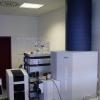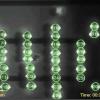Research
Studies of enzyme reaction by CE, which have been under active investigation in recent years [1], include i) enzyme reaction prior CE analysis; ii) enzyme reaction during CE analysis also known as electrophoretically mediated microanalysis (EMMA) and iii) application of immobilized enzyme reactor (IMER). Among them the EMMA and IMER based methods have shown a high degree of versatility and attracted most research attentions, because of low detection limits, short analysis times and automation.
In this project the special attention will be paid on the affinity capillary electrophoresis (ACE). This CE modification is a versatile analytical technique that has been shown to be an efficient and accurate tool to probe non-covalent interactions and to determine binding and dissociation constants between receptors and ligands. It utilizes the resolving power of CE to distinguish between free and bound forms of a receptor as a function of the concentration of free ligand.
We have studied preparation and applications of several kinds of nanoparticles. Certain nanoparticles of semiconductor materials exhibit a strong luminescence with a broad excitation and very narrow emission spectrum. These nanoparticles, often called quantum dots (QD), have unique properties when compared with standard fluorophores. Besides the very narrow emission an important advantage of using QDs instead of standard fluorescent molecules is their stability towards photobleaching (important for extended imaging times).
Proteins are mostly characterized using mass spectrometry (MS) after proteolysis. However, it should be difficult to analyze specific group of proteins ,e.g. phosphopeptides, by MS due to lower ionization efficiency in the presence of other peptides. Therefore, an efficient enrichment using selective affinity techniques prior to MS detection is necessary to increase their ionization efficiency and detection sensitivity from highly complex peptide mixtures. We have developed a new monolithic capillary column with an iron oxide nanoparticle coating for enrichment of phosphopeptides.
We study the problem of distributed planar manipulation by shaping a force field derived from a potential field commanded by an actuator array. The shapes of the spatially continuous fields are commanded through a set of spatially discrete nodes (actuators) such as electrodes in the case of dielectrophroesis, electromagnets in the case of planar magnetic manipulators, or linear piezoelectric actuator in the case of deformable flat surfaces.





